Single update#
There are two types of Firmware update:
- Basic Firmware Update for a remote update of the LwM2M device firmware by using the Firmware Update Object
/5. - Multi-component Firmware Update for a remote update of the LwM2M device's firmware component by using the Advanced Firmware Update Object
/33629. Object/33629is designed as an extension of the Firmware Update object/5. It supports multiple instances, each representing a "component" of the device's firmware that can be upgraded separately. The specific meaning and purpose of these components are not standardized and can vary depending on the implementation. However, they typically encompass elements such as bootloaders, application code, cellular modem firmwares, security processor firmwares, and other related firmware entities.
Info
Multi-component Firmware Update is the internal implementation, while Advanced Firmware Update Object /33629 is supported by CoioteDM and Anjay only.
Prerequisites#
- An active Coiote IoT DM user account
- A device which supports Firmware Update Object
/5
Note
The Anjay LwM2M Client supports the Firmware Update Object. Learn more about Anjay by visiting the official Anjay Documentation site or Anjay SDK on GitHub.
Firmware Update Object /5#
The Firmware Update process is defined in the Firmware Update Object /5. This Object contains Resources which define the update process using 4 Update States (representing the phase of the update process) and 11 Update Results (representing the most common outcomes of the firmware update process).
- Resource
/5/*/3represents the State - Resource
/5/*/5represents the Update Result
| ID | State | Description |
|---|---|---|
state 0 |
Idle | Before downloading and after successfully updating |
state 1 |
Downloading | The new firmware is on the way |
state 2 |
Downloaded | The firmware download is completed |
state 3 |
Updating | The Client starts updating its firmware, after which it changes its state back to Idle |
| Result | Description |
|---|---|
update result 0 |
Initial value |
update result 1 |
Firmware updated successfully |
update result 2 |
Insufficient flash memory for the new firmware package |
update result 3 |
Out of RAM during downloading proces |
update result 4 |
Connection lost during downloading process |
update result 5 |
Integrity check failure for new downloaded package |
update result 6 |
Unsupported package type |
update result 7 |
Invalid URI |
update result 8 |
Firmware update failed |
update result 9 |
Unsupported protocol |
update result 10 |
Firmware update cancelled |
update result 11 |
Firmware update deferred |
Info
Learn more about the Firmware Update Object in the OMA LwM2M Object and Resource Registry.
Firmware Update Object /33629#
Object /33629 defines the update process using 4 Update States representing the phase of the update process. Additionally, a total of 13 Update Results may be reported, representing the most common outcomes of the firmware update process.
- Resource
/33629/*/3represents the State - Resource
/33629/*/5represents the Update Result
| ID | State | Description |
|---|---|---|
state 0 |
Idle | Before downloading and after successfully updating |
state 1 |
Downloading | The new firmware is on the way |
state 2 |
Downloaded | The firmware download is completed |
state 3 |
Updating | The Client starts updating its firmware, after which it changes its state back to Idle |
| Result | Description |
|---|---|
update result 0 |
Initial value |
update result 1 |
Firmware updated successfully |
update result 2 |
Insufficient flash memory for the new firmware package |
update result 3 |
Out of RAM during downloading proces |
update result 4 |
Connection lost during downloading process |
update result 5 |
Integrity check failure for new downloaded package |
update result 6 |
Unsupported package type |
update result 7 |
Invalid URI |
update result 8 |
Firmware update failed |
update result 9 |
Unsupported protocol |
update result 10 |
Firmware update cancelled |
update result 11 |
Firmware update deferred |
update result 12 |
Conflicting state |
update result 13 |
Dependency error |
Firmware Update Dashboard#
In the Device Center, in the Firmware update tab, you can find cards with information on the selected Firmware Update.
- Device Firmware shows the last recorded information on the current firmware version.
- Status contains the information on the firmware concerned and shows if this firmware is a part of the FOTA campaign. It also indicates the status of the following stages of the Firmware update: Preparing update, Transferring package, Executing update and Cleanup. The Cancel update button allows you to end already started updating process which means that the Firmware update progress won't be saved. This action is only applicable for the devices supporting this feature.
- Upcoming FOTA Campaign update shows the campaign which is identified as the first to perform the next Firmware update on a given device as per the time of creation and its schedule. Once the update starts, the campaign will be moved to the Updates list.
-
Updates list points at the Firmware updates history with the possibility to filter information by: Status, Name, Start time, Finish time, Type, Created, Created by, and Part of FOTA campaign. A reference link to a campaign name enables you to access the FOTA campaign details providing you have the appropriate permissions.
- No information in this field, marked by a hyphen -, means that it's a Single FOTA Firmware update which is not a part of a campaign.
- Whereas inactive information means that you are not eligible to view the details.
The Settings icon allows for enabling and disabling the filters according to your preferences. The More action icon allows for previewing configuration details of a chosen firmware, copying the configuration or canceling the existing one.
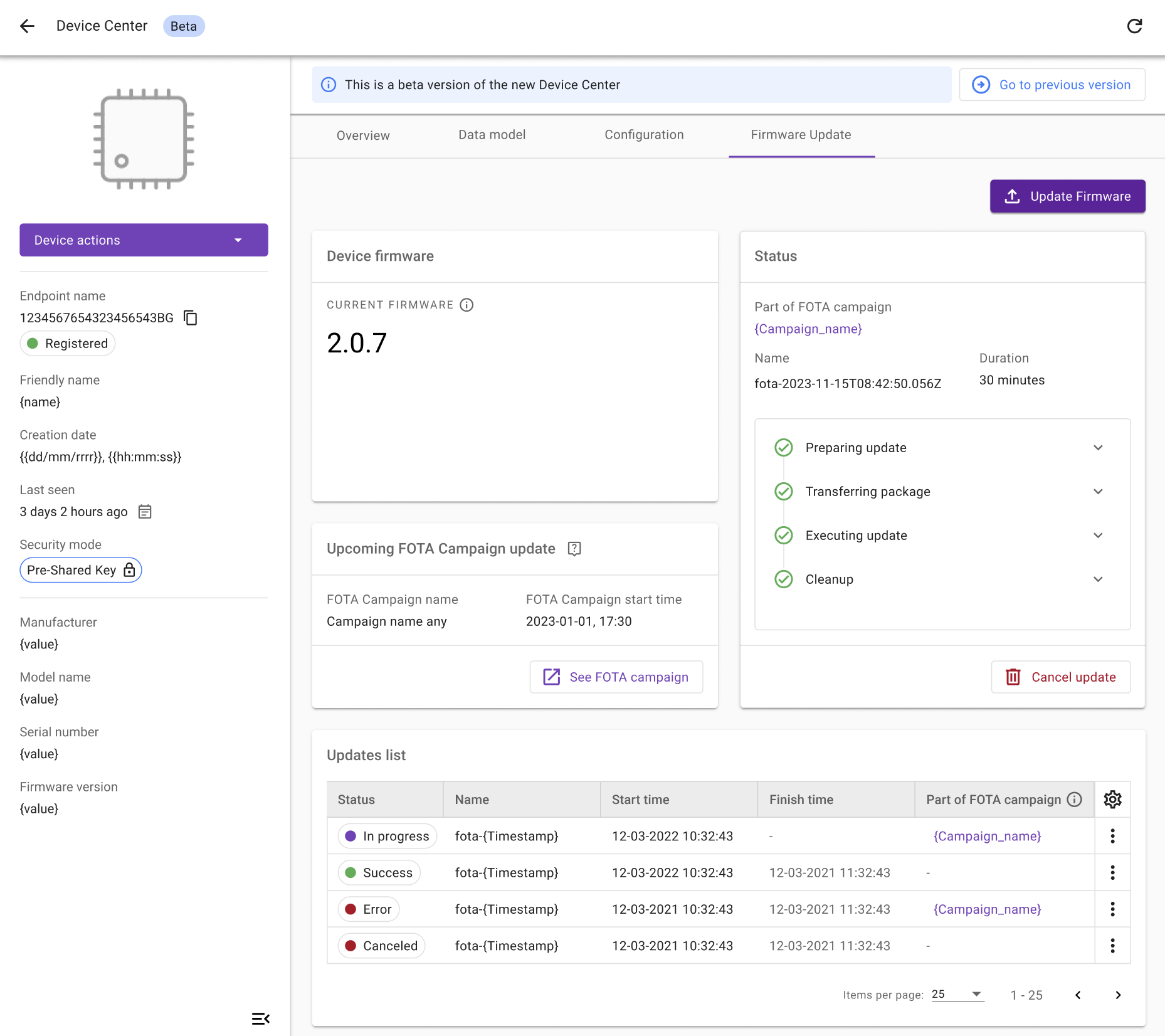
Prepare the Firmware Update#
-
In the Coiote IoT Device Management platform, go to Device Inventory.
-
Select the device you want to update by clicking on its endpoint name.
-
Go to the Data model tab to validate if:
- the Firmware Update Object
/5is present for Basic Firmware Update - the Firmware Update Object
/33629is present for Multi-component Firmware Update
If so, the Object is supported by the LwM2M Client.
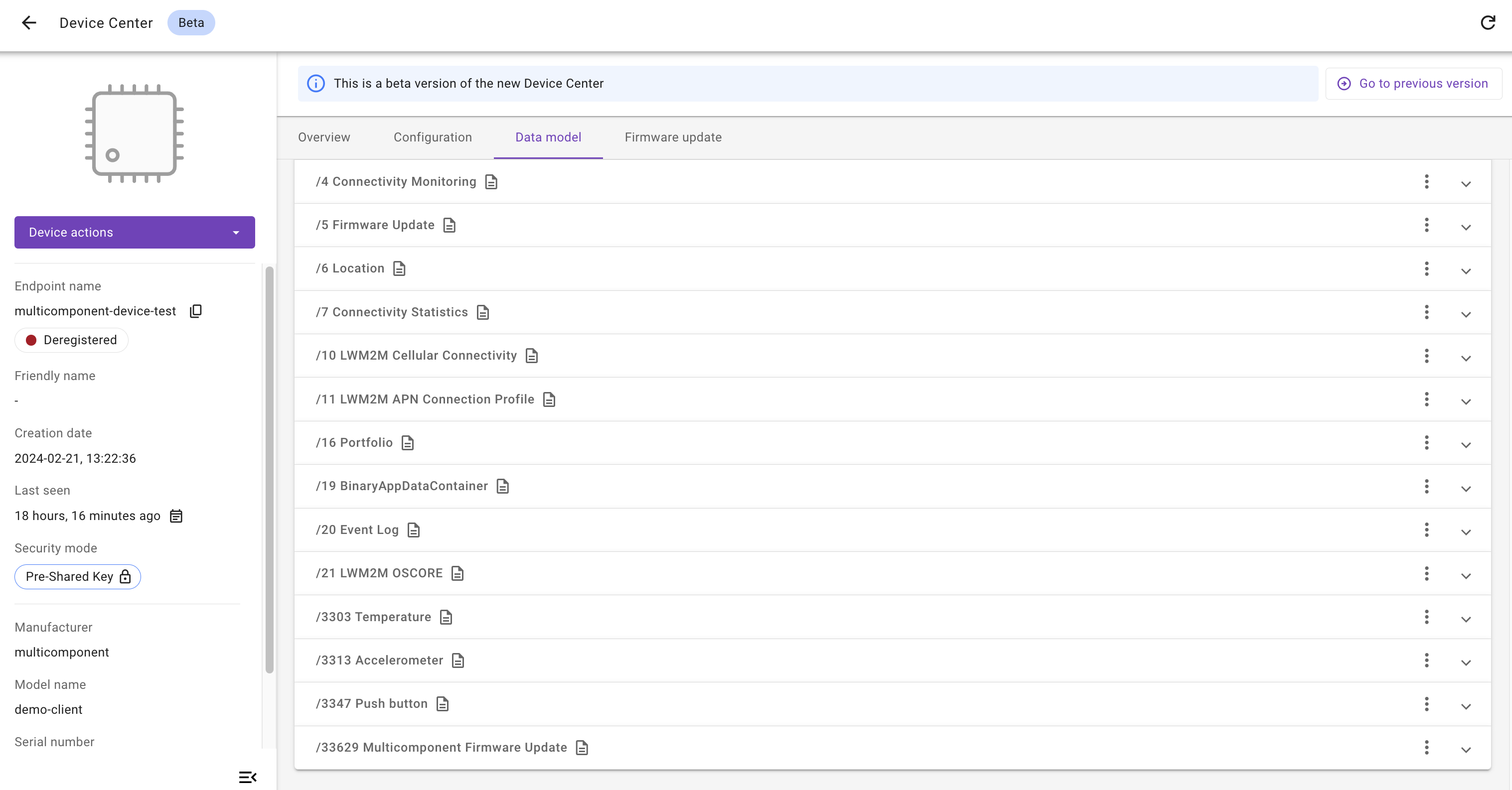
- the Firmware Update Object
-
Go to the Firmware update tab and click Update Firmware.
-
From the drop-down menu, choose the type of Firmware Update that you want to create:
- Basic Firmware Update from an existing configuration
- New Basic Firmware Update
- New Multi-component Firmware Update
Create Basic Firmware update from an existing configuration#
To create basic Firmware update from an existing configuration, perform the following steps:
- Provide a name of the Firmware update.
- Select a FOTA configuration for your Firmware update.
- In the FOTA configuration settings section, preview configuration details before scheduling update.
-
To create Firmware update, click Schedule Update.
If you fill in details correctly, you will see the confirmation that your update has been scheduled successfully.
Create new Basic Firmware update#
To create new, basic Firmware update, perform the following steps:
- Provide a name of the Firmware update.
- Upload a new firmware image or choose one from the resources.
-
Optionally, in the Description field, provide information about the Firmware version.
Info
You can save FOTA configuration after its creation by enabling the appropriate toggle switch. Once it's activated, you can also make the configuration visible in subdomains by enabling Visible in domains. In case the configuration is saved for later purposes, the underlying files expiration date is extend to 6 months.

-
To go to Settings, click Next.
-
Choose the image delivery method:
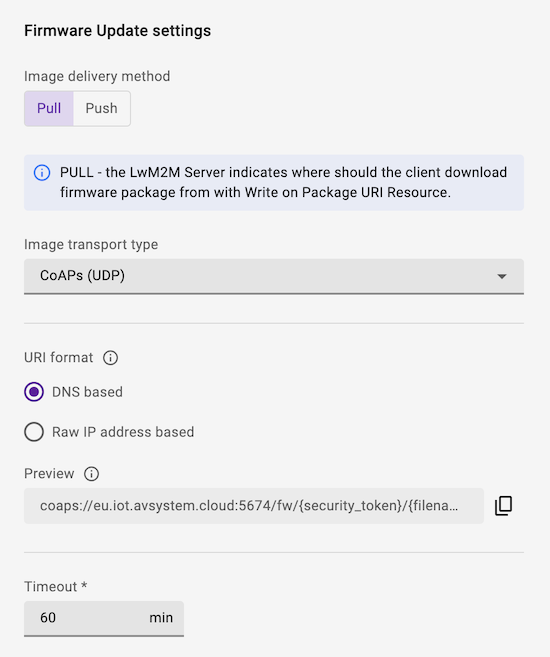
- Pull method (recommended): The LwM2M Client receives the URI of the file that is to be downloaded and pulls the file from it.
Pull supports the following transport types:
CoAPorCoAPsoverUDPCoAPorCoAPsoverTCPHTTPorHTTPs
- Push method: The LwM2M Server pushes the firmware file to the device.
Push transmits the firmware over the same transport type as is used for device management, which is
CoAPsoverUDPby default.
Which transport protocol to choose?
Downloads using
CoAP(s)overUDPtend to be slow due to the limitation of the maximum CoAP Block size of 1024 bytes and the required acknowledgements for each Block transfer. ChoosingCoAP(s)overTCPorHTTP(s)usually results in faster download speeds. However, not every device supports these transport protocols. - Pull method (recommended): The LwM2M Client receives the URI of the file that is to be downloaded and pulls the file from it.
Pull supports the following transport types:
-
Choose the URI format in which the URL will be send to the firmware package.
Info
In the Preview field, you can verify the location of the security token.
-
Once you check the details in Firmware Update Flow Preview, click Next.
-
In the Summary section, preview the Firmware update information and click Schedule Update.
If you filled in the details correctly, you will see the confirmation that the Firmware update has been scheduled successfully.
Create new, multi-component Firmware update#
To create new, multi-component Firmware update, perform the following steps:
- Provide a name of the Firmware update.
-
Optionally, in the Description field, provide information about your Firmware version.
Info
You can save FOTA configuration after its creation by enabling the appropriate toggle switch. Once it's activated, you can also make the configuration visible in subdomains by enabling Visible in domains. In case the configuration is saved for later purposes, the underlying files expiration date is extended to 6 months.

-
To go to the component selection, click Next.
- To select more than one component, click Add new component and upload a new firmware or choose one from resources.

- To go to Settings, click Next.
-
Choose the image delivery method:

-
Pull method (recommended): The LwM2M Client receives the URI of the file that is to be downloaded and pulls the file from it. Pull supports the following transport types:
CoAPorCoAPsoverUDPCoAPorCoAPsoverTCPHTTPorHTTPs
-
Push method: The LwM2M Server pushes the firmware file to the device. Push transmits the firmware over the same transport type as is used for device management, which is
CoAPsoverUDPby default.
Which transport protocol to choose?
Downloads using
CoAP(s)overUDPtend to be slow due to the limitation of the maximum CoAP Block size of 1024 bytes and the required acknowledgements for each Block transfer. ChoosingCoAP(s)overTCPorHTTP(s)usually results in faster download speeds. However, not every device supports these transport protocols. -
-
Choose the URI format in which the URL will be send to the firmware package.
Info
In the Preview field, you can verify the location of the security token.
-
Once you check the details in the Firmware Update Flow Preview section, click Next.
-
In the Summary section, preview the Firmware update information and click Schedule Update.
If you filled in the details correctly, the Firmware update will be scheduled successfully.
Download & Upgrade Process#
If the Firmware Update is scheduled successfully, the device starts downloading the firmware at the next practical opportunity. The actual firmware update starts once the integrity and authenticity of the firmware image has been validated by the LwM2M Client.
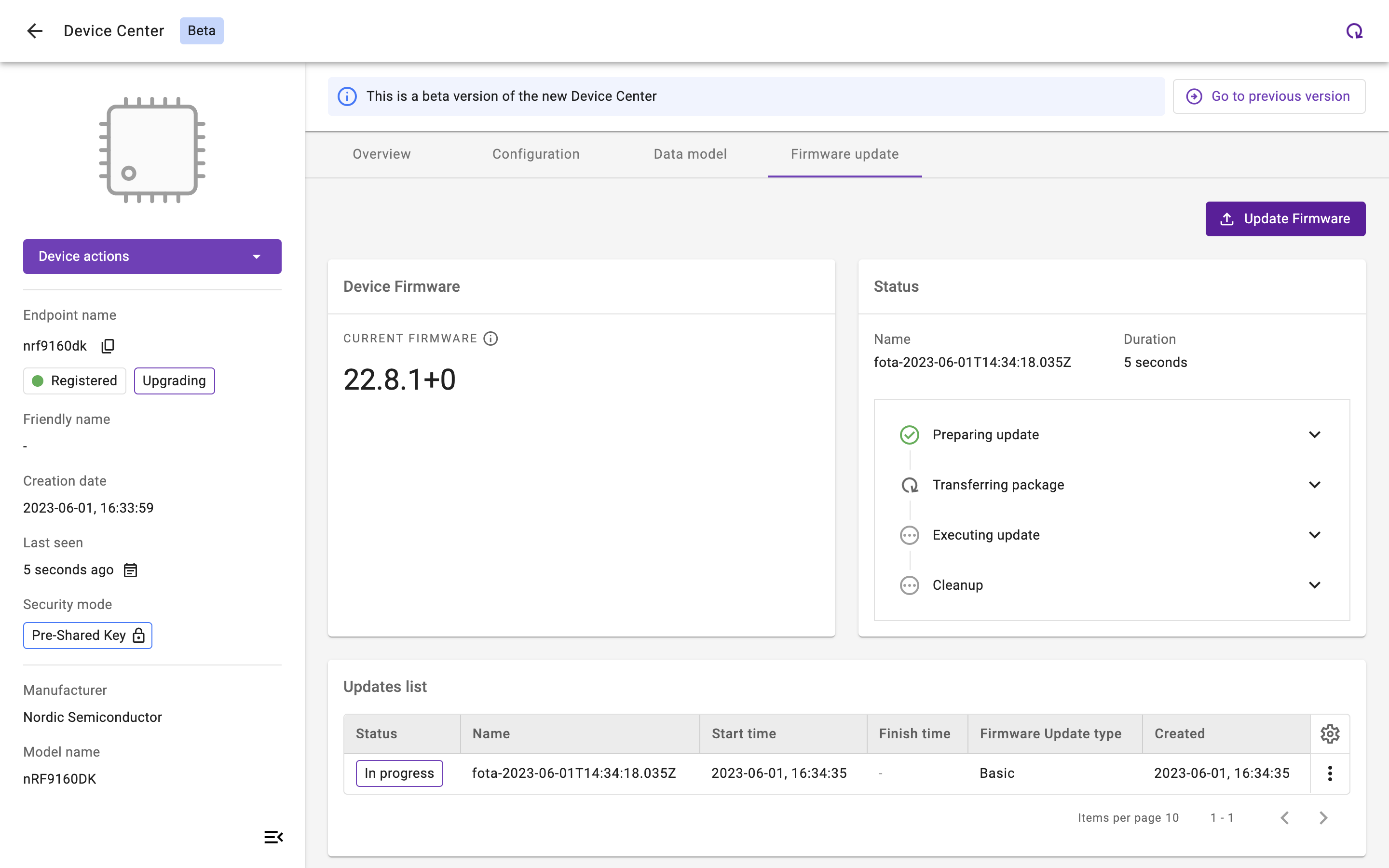
Once executed successfully, the status in the Update list panel changes to Success.
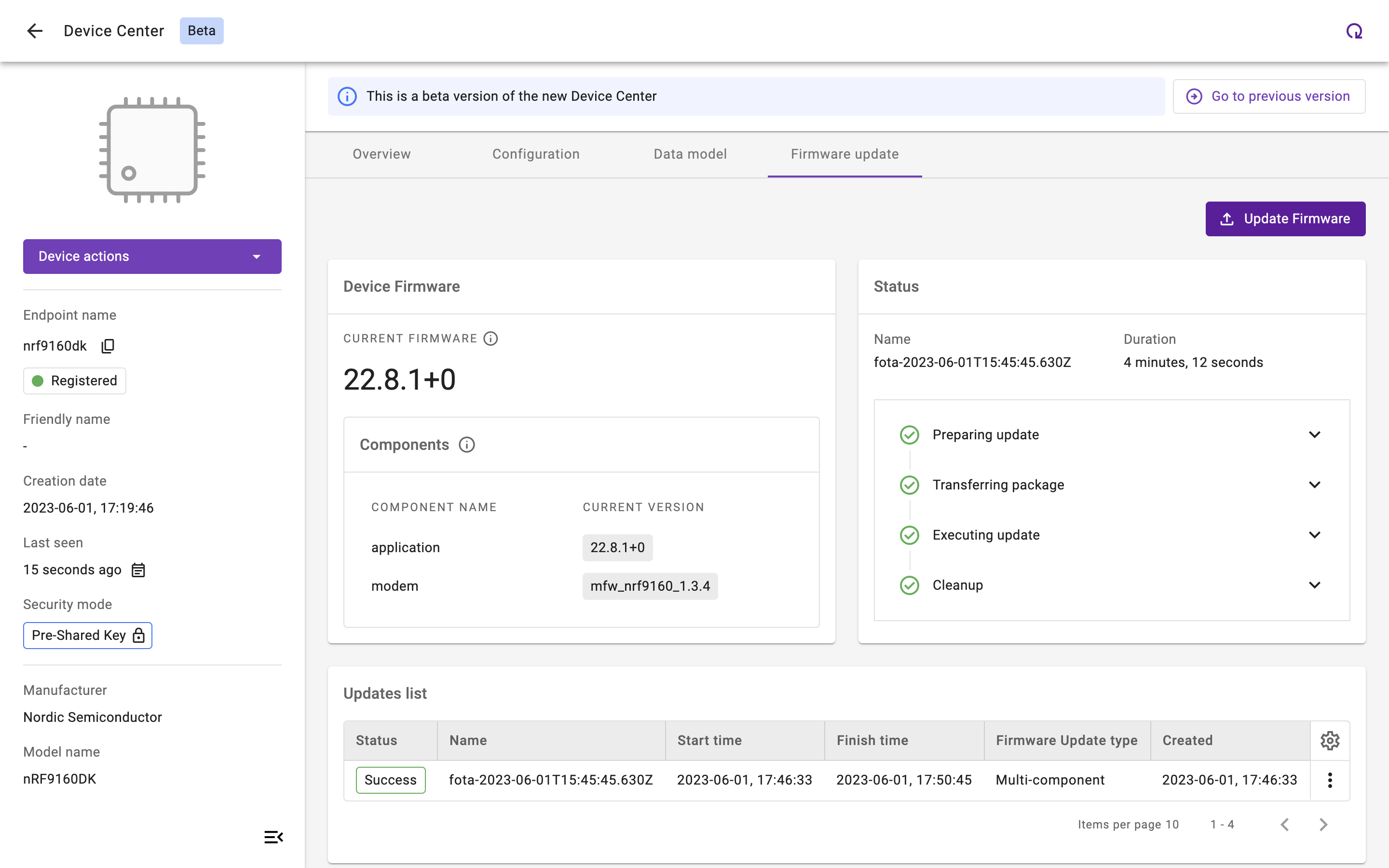
Note
While the device is updating its firmware, it will deregister and reboot by using the new firmware. This process may time several minutes.

Monitoring the update process#
You can monitor the status of the Firmware update by reviewing the following resources:
- State
/5/*/3and Update Results/5/*/5for Basic Firmware Update - State
/33629/*/3and Update Results/33629/*/5for Multi-component Firmware Update
To find the Resources, select the Data model tab and open:
- Firmware Update Object
/5for Basic Firmware Update - Advanced Firmware Update Object
/33629for Multi-component Firmware Update

If no errors occur, the update process follows this pattern:
- Downloading
state 1&update result 0 - Downloaded
state 2&update result 0 - Updating
state 3&update result 0 - Updated
state 0&update result 1
Update successful?
- If the State
/5/*/3reports0and the Update Results/5/*/5reports1for Basic Firmware Update, the firmware device has been completed successfully. Congratulations! - If the State
/33629/*/3reports0and the Update Results/33629/*/5reports1for Multi-component Firmware Update, the firmware device has been completed successfully. Congratulations!
REST API#
REST API Documentation supports Basic Firmware Update and Multi-component Firmware Update for the the updates which use an existing configuration. For more information, see the Firmware Configurations, Firmware Campaigns or Single Update sections.
Troubleshooting#
Firmware Update only works over CoAP, not over CoAPs - sample issue#
For the firmware update over CoAPs transfer to work, the LwM2M Client must use the same security credentials (i.e. PSK or certificates) as those used for the management interface. This is the default behavior of the Anjay client, but you might need to configure it explicitly when using other LwM2M Client implementations.
Zephyr LwM2M Client configuration instruction
The security tags needs to the same in the "Security tag for FOTA download library" as in the "LwM2M server TLS tag" (e.g. using Nordic's default tag: 35724861).
To update the security tags, edit the Kconfig in the directory:
Zephyr Kernel
> Modules
> nrf
> Nordic nRF Connect
> Networking
> Application protocols
> LwM2M client utilities library
> Security object support
> Firmware Update object support
 Kconfig editor in nRF Connect for VS Code
Kconfig editor in nRF Connect for VS Code
Useful Links#
- Anjay firmware update documentation
- Anjay SDK
- Anjay Zephyr SDK
- Anjay ESP32 SDK
- OMA LwM2M Object and Resource Registry